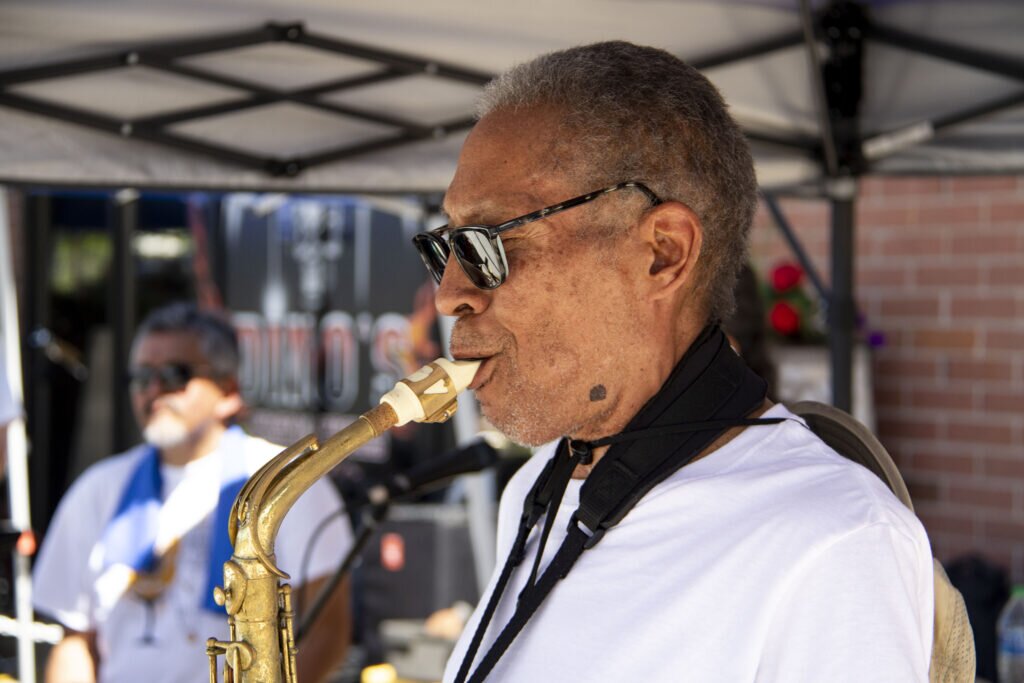The story behind the rad skaters of Denver's 1983 Juneteenth celebration

DENVER — Last year, in honor of the federal government’s official recognition of Juneteenth, we dug into the archives at the Blair-Caldwell African American Research Library to bring you historic photos of celebrations on Welton Street. Though many Americans were just becoming aware of the holiday in 2021, it’s been a big deal in Five Points for over 50 years.
One photo stood out: a shot of 26th and Welton with five fit dudes on roller skates. Monique was set to play Junior’s House of Music behind them (now the Roxy). Crowds lined the street as they passed. Their short shorts and deep stances were evidence of style and confidence. We were dying to know more. Luckily, the internet helped us connect with some members of the crew.
“We were quite the spectacle. And everyone was attracted to us. Especially the women.”
Marvin Bailey, third from the left in the photo, moved to Park Hill with his family as a kid. He didn’t get into the skating life until he was older, when he paid a visit to Venice Beach. He saw people cruising by the beach and was bit hard by the roller bug.
“I said, ‘Shoot, I could do that back home,'” he recalled.
When he returned to Denver, he bought himself a pair of skates. Soon he was meeting up with his friends Dana Singleton, Bobby Miles, Chucky Banks and Rex Ramsey in City Park to do some laps and then head deeper into the city.
What did Bailey love about it?
“Being out in the open, seeing a lot of people and seeing a lot of things,” he told us. “Just hanging out with the boys.”
The day their photo was taken on Welton Street, Bailey said they were just looking for some crowds. Most of the group grew up going to Juneteenth in Five Points, so they knew what they were heading into. Populated areas were key for him; while he liked the exercise, he was also out to be seen.
“It was a chick magnet for most of the guys. They got a lot of numbers and dated a lot of girls,” he said.
The shorts helped, too.
“I picked up my shorts in Venice, California, on the boardwalk, and I had some that were even shorter,” he told us. “They were quite revealing.”
The dating tactic worked. Bailey told us he met his ex-wife at City Park while he was rolling around with his boys.
“I was skating there. She was hanging with her girlfriends,” he laughed. “I was quite the gigolo back then.”
Their grace and style also caught the eye of someone from Rocky Mountain PBS who met the crew in Cheesman Park in 1982 and featured them in a music video at the end of a “Season Ticket” episode.
“I liked the feeling of the freedom.”
Dana Singleton said the simple joy of smooth pavement got him out every day, more so than picking up women.
“If you found a good piece of pavement it was great,” he told us, “and the camaraderie.”
As they rolled through town, each usually wore their own Walkman stereos and moved to their own soundtracks. Singleton said he was big on Earth, Wind and Fire in the ’80s.
And while indoor skating was a thing in the culture in those days, he said he always stuck to city streets. A teacher, he had all summer to go out and feel the rush.
Singleton said the crew experimented with tricks and trips. Once, they drove west to roll around Vail and Aspen. They sought out hills, like a monster on Kipling that they’d race down at “55 miles an hour.”
Singleton said he’s not in for those kinds of thrills anymore.
“No, man, I’m 64 years old,” he said, “but I still play music.”

Though there weren’t a lot of skaters in Denver, both Singleton and Bailey said the city accepted them. Bailey said the city was “friendlier” back then, both from a human and safety perspective.
“We were a lot more able to skate in the streets, and traffic was nowhere close to what it is now,” he said, adding that they felt comfortable rolling down Colorado Boulevard. “Times were good, friendlier people. Neighborhoods were more open.”
But Bailey said one negative encounter did stick in his mind, a moment when a cyclist attacked the crew in Washington Park.
“You guys need to get the f*** out of here. This is our park. This is for bicycles,” he remembered the man saying after he tried to “wail” on one of his friends. “I got him on the ground and he started biting me!”
While people loved them at most parks, it felt like people at Wash Park had some kind of chip on their shoulders.

But Bailey and Singleton both look back on those days with fondness and nostalgia. The crew drifted apart over the years. They grew up and moved on. But Bailey was delighted to reconnect with Singleton over the photo.
“Tell my baby brother hello and I miss him,” Bailey wrote us when we went to meet Singleton for a portrait. “Those were great times. (The photo) brought back a lot of good memories.”
You can explore other DPL Archives stories from Denverite here.
